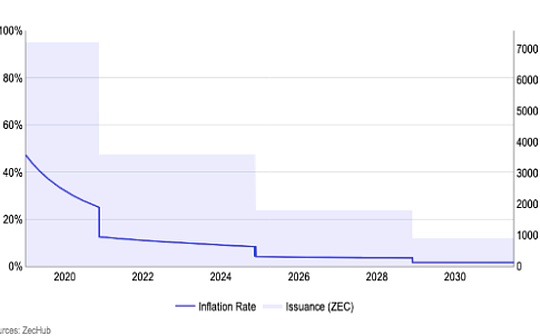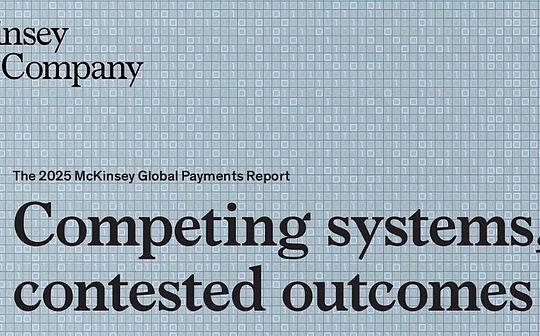
The payments industry in 2025 is at an inflection point.What was once a quest for universal efficiency has now evolved into a competition among multiple market systems, each with its own unique philosophies, capabilities, and limitations.Some systems focus on control and interoperability through centralized infrastructure, while others prioritize decentralization, programmability, and private rails.There are also systems that embed payment capabilities into platforms, devices, and networks that are not traditionally associated with finance.
How money flows is becoming as critical as the amount of money.Whether it’s payroll payments in Southeast Asia, business-to-business settlements in Europe, or retail checkouts in Latin America, the design choices made today are shaping the payments landscape over the next decade and will determine who will lead, who will follow, and who will fall behind.
The global financial system is affected by non-financial factors such as tariffs, data governance rules, energy constraints and national security priorities.The growing fragmentation in the payments landscape reflectsThe entire financial system is evolving into a regional mosaic of different standards, timelines, currencies and trust anchors.
Against this backdrop, the payments industry remains the most valuable segment of financial services, generating $2.5 trillion in revenue (0.125% take rate) from $2000 trillion in value flows and supporting 3.6 trillion transaction volumes globally.
As a result, we will integrate the payment and finance of stablecoins/tokenized currencies into the entire global payment landscape. In other words, from a Fintech perspective, who will integrate, how to integrate these fragmented systems caused by geopolitical and other factors, and how to adapt to the development of the next payment era based on their own advantages are issues that all market players need to think about now.
The McKinsey Global Payments Report 2025 provides insights into the rise of diverse payment rails, the impact of digital assets, and the transformative power of artificial intelligence, providing a roadmap for success in the rapidly evolving global payments ecosystem.The report identifies the key elements required to remain competitive in a rapidly changing environment.This report is based on McKinsey’s “Global Payments Map” analysis, which covers data from 50 countries and more than 20 payment methods, accounting for 95% of global GDP.The report is divided into three parts:
-
A basic forecast of industry growth until 2029, with a detailed analysis of how economic fluctuations and policy changes will lead to significant divergence in profit margins and revenue structures.Focus on thinking about whether new revenue points can be created by integrating multiple payment tracks, which is an important driver of payment development.
-
Key forces reshaping the payments landscape include the monetization of AI-native operations and AI agents, emerging models of programmable payments liquidity, and regulated digital currencies.Focus on thinking about what changes these emerging forces will bring to the original model.
-
The key points that payment operators should focus on in transforming their systems are agility, architecture and trust.Focus on thinking about how to capture value.
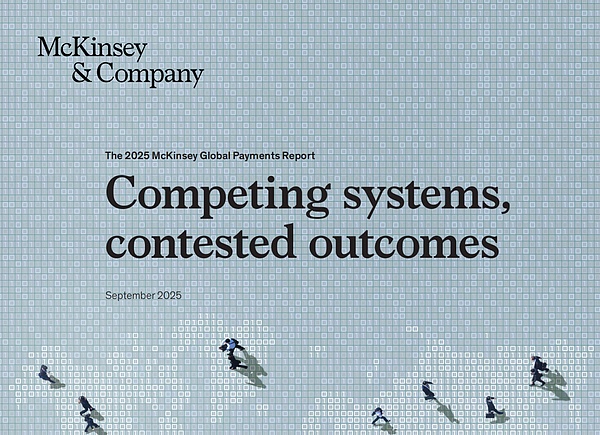
1. Payment income in the new economic era
Global payments revenue will grow at an average annual rate of 7% between 2019 and 2024.Interest income will account for 46% of total revenue in 2024, driven by higher interest rates.Growth fell to 4% for the year, significantly slower than 12% in 2023.Reasons for the slowdown include peaking interest rates, weakening macroeconomics, structural expansion of low-yield payment methods, and continued fee squeeze.
In terms of regions, Latin America grew by 11%, Europe, Central Africa (EMEA) and North America grew by 8% and 5% respectively, while Asia Pacific (APAC) fell by 1%.Despite this, payments remain the most valuable sub-sector in finance, with an average return on equity of 18.9% in 2024, with some institutions exceeding 100%.
However, as interest rates peak and fall in many countries and deposit behavior changes, net interest income is expected to only increase by about 2% annually (until 2029) unless there is a major impact.At the same time, consumers are increasingly turning to low-cost methods such as account direct transfer and digital wallets, and transaction-based revenue growth will also slow down.Continuous pricing pressure (especially in the card-based ecosystem), tighter supervision and the rise of platform-based payment experiences are squeezing the fee model.Therefore, we predict that the average annual growth rate of industry revenue will maintain 4% before 2029. If the world is disrupted, it may be as low as 3%, and if productivity improvement accelerates, it can reach 6%.Calculated at 4%, the total market size will reach US$3.0 trillion by 2029.
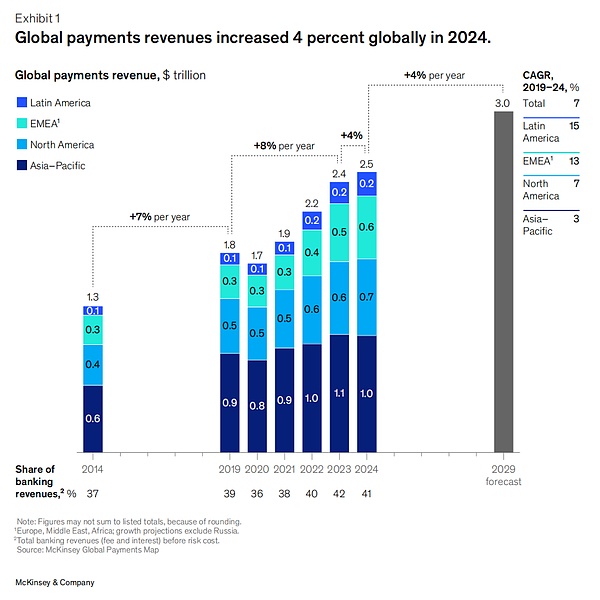
1.1 Global Payment Trends
Overall, global payment revenue is almost evenly split between the consumer and commercial sides, but there are significant differences in the composition of each region.
-
North America is biased toward consumer payments as credit cards serve as both a primary payment instrument and a means of borrowing, reflecting the maturity of the consumer credit market and the strength of card loyalty programs.
-
The Asia-Pacific region is more commercial, with 25% of revenue coming from commercial account net interest income (NII), highlighting the deep corporate banking relationships and the reliance of fast-growing economies on deposit interest.
-
Europe, Central Africa (EMEA) has the most diverse structure: 20% of revenue comes from commercial accounts NII related to trade and treasury activities, and 20% comes from consumer accounts NII, benefiting from Europe’s higher savings base.
-
Latin America, like North America, is also skewed toward consumers, with consumer credit card revenue accounting for 32% of total revenue, reflecting the importance of revolving credit and consumers’ reliance on installment payments.
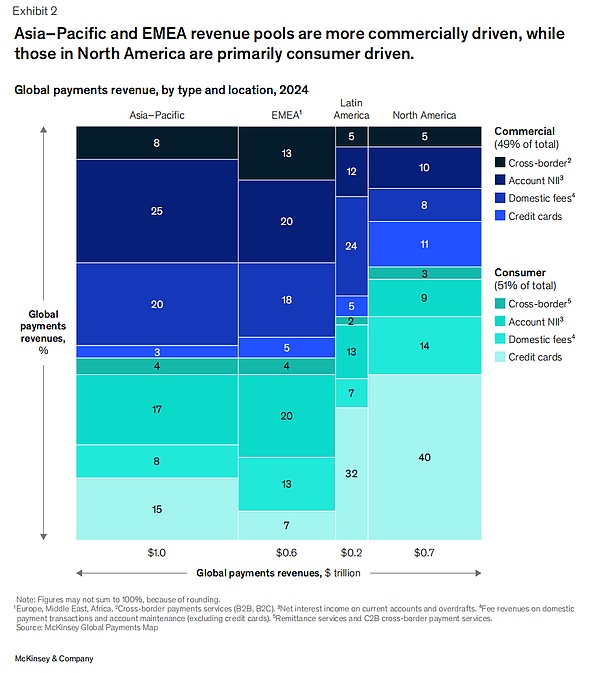
1.2 Payment development trends under income structure
Global cash usage continues to decline, with its share of all payments falling from 50% in 2023 to 46%.Account-to-account (A2A) payments are growing in popularity, especially transactions completed through digital wallets, and now account for approximately 30% of total point-of-sale (POS) volume globally, with markets such as India, Brazil and Nigeria leading the way.
As transaction volume shifts to lower-yield tracks such as instant payments, monetization becomes more difficult; this problem is particularly acute in markets where exchange fees and processing fees are strictly regulated.We expect that new economics and fee models will gradually emerge in the A2A space, possibly following the example in India where banks have started charging payment aggregators for Unified Payments Interface (UPI) merchant transactions.
In business-to-business (B2B) payments, digitization has been fully rolled out, but it is mainly concentrated on low-profit channels such as bank transfers and instant payments.To capture value, businesses, especially software-centric ones, are investing in value-added services, including invoice automation, reconciliation and working capital tools; these services are particularly important in small and medium-sized enterprises and in industries such as healthcare that still rely on manual processes.
Finally, new technologies continue to bring opportunities and threats.From tokenized currencies and digital currencies to AI-based anti-fraud and liquidity management, innovations improve security, efficiency and reach.However, adoption has been mixed.Regulatory uncertainty, infrastructure gaps and inconsistent technical standards have kept progress from occurring in localized isolation.
2. Three major forces reshaping global payments
There are three structural forces that could revolutionize the way money flows between individuals, businesses and intermediaries:
-
The payment system is increasingly fragmented and regionalized;
-
Large-scale application of digital assets in payment scenarios;
-
The transformative potential of artificial intelligence.
2.1 Fragmentation and regionalization of payment landscape
The global payment ecosystem is entering an unprecedentedly complex stage, against the backdrop of a high degree of interconnection of goods, services and people.Over the past 30 years, globalization has ensured the smooth flow of funds across borders.However, geopolitical events have prompted some countries and regions to reduce their reliance on global standards and systems.For example, sanctions against Russia have excluded it from international card organizations, relying instead on Mir cards to handle domestic transactions and contracting with China UnionPay to handle international demand.Some countries and regions are promoting “payment sovereignty” to reduce dependence on global intermediaries; the European Central Bank is vigorously promoting a large-scale system with Europe as the core.
at the same time,Technological progress has accelerated the growth of localized and regionalized payment systems.The construction of instant payment infrastructure is particularly critical, which creates an excellent user experience (typically such as Brazilian Pix, Spanish Bizum, and Indian UPI).The interoperability between more and more domestic instant payment systems provides new paths for cross-border payments beyond traditional standards.Among them, Pix’s internationalization in Latin America and National Payments Corporation of India’s (NPCI) expansion to the Middle East and Southeast Asia are outstanding and rapidly developing cases.At the same time, the rapid popularity of stablecoins is also creating a new channel that is different from the traditional payment track.
These geopolitical and technological changes are reshaping the payments landscape, bringing greater regionalization and diversification.It is impossible to return to the fully globalized payment system of five years ago because the forces driving fragmentation have already begun.However, many alternative payment systems have encountered obstacles in the process of expansion: poor user experience, unclear value propositions, governance flaws, lack of supporting legislation in key markets and other problems emerge in endlessly; in some scenarios, traditional old systems have shown enough resilience to even bypass or defeat new solutions.
Therefore, the payment landscape is evolving towards two outcomes that are more fragmented than they are now: one is a diversified ecology of “multi-track + global access keys”; the other is a divided world of “increased localization + decline of global standards”.
Scenario A: Multi-track ecology equipped with “global access key”
In a more optimistic scenario, geopolitical tensions stabilize or ease, and payment standards remain strong and serve as a “global passkey” for multiple payment scenarios and customer types.The scope of services can be broad or narrow – from online shopping to a series of value-added services; the depth of services can be deep or shallow – from cross-border financial solutions for a certain industry to simple remittances for the general public.
In this environment, all parties involved must deal with multiple challenges: they must not only monitor and supervise the flow of funds across multiple tracks, but also face huge differences in economic benefits between different use cases and systems, and also complete the technical docking between systems.As a result, a group of “integrators” and “aggregators” may be spawned, which can seamlessly connect multiple payment systems.In this scenario, although the payment system is more fragmented than it is now, it can breed innovation and specialization, allowing diversified solutions to coexist and meet the needs of market segments.
Scenario B: Fragmentation escalates and global standards are eroded
If global trade and commerce continue to encounter major challenges and geopolitical tensions intensify, countries may become increasingly dependent on local and regional alliances and gradually withdraw from the global flow of goods, services and people.The background to this scenario is that the world has failed to build a framework for the coexistence of the “global system” and the “local system.”By then, the payment system will inevitably move toward regionalization.
Countries and regions will prioritize resilience and self-sufficiency, leading to more bilateral agreements, intermediary currencies and alternative payment systems that move further away from global standards.Over time, regional systems and payment tools will dominate use cases, fundamentally reshaping the financial landscape.International interconnection will become more difficult, which will have a profound impact on the payment technology stack, especially for institutions with multinational and global layouts.This could accelerate the adoption of stablecoins and tokenized currencies.
Although the international interconnection in the first scenario is smoother, both mean that the unified global payment landscape in the past will be further fragmented and complicated, and solutions will become more localized.For businesses and financial institutions to adapt to this new reality, they must have flexibility, innovation and a deep understanding of the forces driving capital flows.
2.2 Stablecoins and tokenized currencies (TOKened Money) accelerated adoption of
Stablecoins and tokenized currencies are increasingly becoming an important part of the financial system, although they have not yet crossed the tipping point of widespread adoption.The industry is expanding rapidly—stablecoin issuance has doubled since the start of 2024—but its share of the trillions of dollars in daily global payments remains limited: average daily trading volume currently stands at about $30 billion.
Multiple signals show that stablecoins are approaching a “breaking” moment.The primary factor is the increasingly clear regulatory rules: the United States (the recently passed GENIUS Act), the European Union, the United Kingdom, Hong Kong and Japan have all introduced or improved regulatory frameworks to clarify key requirements such as licensing, reserve management, anti-money laundering and customer due diligence.Whether the cross-regional framework can be aligned will determine whether the cross-border stablecoin business can be launched; and the clarity of the rules itself will lower the entry threshold, which will especially benefit traditional financial institutions and increase market confidence in stablecoins.
The technical infrastructure is also rapidly upgrading: by migrating transaction processing from the main network to the more scalable Layer 2 and adopting more efficient consensus protocols, throughput continues to improve; user-oriented digital wallets and bank-level custody solutions are becoming more reliable and accessible; advanced on-chain analysis tools enhance security and compliance capabilities.
A more convincing driving force comes from real scene requirements.Although stablecoins were initially only popular in niche areas such as crypto-asset transaction settlement, their potential has been recognized by a wider range of use cases: tokenized deposits allow customers to accrue interest within the day and are available at any time; stablecoins can provide “7×24” real-time settlement, becoming an alternative to traditional correspondent banking networks; in areas where local currencies fluctuate violently, stablecoins anchored to major global currencies can hedge against inflation for consumers.Institutional-level applications are also beginning to emerge, such as B2B treasury management, supply chain financing, repurchase agreements, etc.In addition, the “programmable” nature of stablecoins can lead to new scenarios, including solving custody problems and limiting government benefits to specific consumption categories.
Over the past 18 months, a number of high-profile official announcements, partnerships and mergers and acquisitions have demonstrated that the industry is fully committed to capturing the value of tokenized assets.However, widespread adoption also brings risks that must be carefully managed.Although regulation in major markets is becoming clearer, the world still lacks a unified and coherent regulatory framework, which may cause uncertainty and even market disruption.If an issuer has insufficient reserves, the stablecoin may become unanchored and trust may collapse; once the leading stablecoin fails, the shock wave may spread to the wider financial system.
In addition, for stablecoins to be truly popular, end users need to change their temporary mentality of “just a bridge for fiat currency exchange” and become willing to hold them for a long time.Once most customers keep their funds in stablecoins, traditional banks’ deposit funding sources and income models will be subverted.
The rise of stablecoins also coincides with the trend of “multi-track payments” – for example, merchant acquirers support card swiping, A2A transfers and stablecoins in a unified solution.Leading companies have taken important steps: PayPal now accepts payments in a variety of digital assets; Coinbase has launched a debit card tied to a stablecoin, and credit card products are on the way.If other service providers want to meet customers’ stablecoin-related needs, they must make a choice: build their own capabilities or cooperate with aggregators and integrators.
3. The path forward for payment participants
As the global payments landscape restructures into a mosaic of multiple tracks, digital assets and intelligent AI agents, many possible paths will emerge for industry participants.
This chapter breaks down the key choices faced by payment institutions, merchants, platform providers and solution experts, and explores how each segment positions itself, continues to innovate, and captures value in an increasingly “decentralized, programmable, real-time” environment.
3.1 Payment providers: fighting for brand and trust
When AI agents begin to dominate more consumer journeys, the traditional competitive approach that relies on “product differentiation + user experience” may become ineffective.Convenience and personalization will become the basic threshold.The main battlefield will shift to “brand trust and relationship” – whoever can control the interactive interface (whether direct or embedded) can influence consumer decision-making in a highly sticky and difficult-to-substitute way.
At the same time, new rails, stablecoins and programmable currencies will rewrite the economic model of consumer payments.Intelligent agents optimizing “when and how to pay” for consumers may squeeze interchange fee income and spreads, put pressure on the growth of local/regional players, and also impact the dominance of global giants.Large institutions and solution experts that have long relied on “settlement, credit, and liquidity inefficiencies” to make profits need to reshape their value propositions to avoid being “disintermediated” by small players and customers.
The ultimate winners will be those who build intelligent, embedded, secure, and emotionally resonant experiences around “agent-based journeys” that not only anticipate needs and “translate” complex technology into intuitive experiences, but are also explainable and deeply aligned with the brand’s trust promise.
Countries’ emphasis on “payment sovereignty” and local solutions will benefit local/regional players and limit global players.Local institutions can become the “trust anchor” of the local ecosystem (instant payment, identity layer, central bank digital currency platform), promote interoperability, connect networks and comply with local policies; regional players (such as Europe’s Wero, Brazil’s Pix) can lead the economic block by formulating cross-border payment, digital identity and data governance rules.Global players may turn to more flexible and open structures to accommodate judicial differences; in some markets, they may also consider partnering with emerging regional companies to bridge the gap in brand recognition and trust.
3.2 Merchants: Use payment methods to retain customers
Consumer expectations are rising, and merchants are required to provide seamless and scalable experiences that cover multiple payment methods, channels and compliance requirements.AI agents increasingly control the demand side, forcing merchants to acquire customers in new ways and reach new standards in “payment orchestration, checkout intelligence, and personalized offers.”
Merchant payment service providers must upgrade from “supporting acquiring” to “providing autonomous payment infrastructure”: functions such as intelligent routing, real-time settlement, automatic compliance, and dynamic currency optimization will become the default configuration.The biggest opportunity lies in creating an “empowering business layer”, helping merchants achieve customer acquisition, conversion and retention across multiple channels and regions.This layer includes not only acquiring services, but also promotes the further integration of merchant SaaS and payment.Early movers can turn the complexity of “regionalized rails + tokenized currencies” into a competitive advantage through programmable APIs and embedded services.
3.3 Platform provider: Be an ecological enabler
A “large-scale multi-product” platform that spans the value chain and multiple payment rails has the natural advantage of upgrading with AI and programmable currency, which can help traditional customers such as banks accelerate innovation.Its breadth enables it to orchestrate the complete end-customer journey and serve as the “control layer” for AI agents and programmable finance.Rich data resources provide fuel for large-scale decision-making and personalization.
However, many platforms are “large in scope” but “weak in points” and lag behind experts in specific functions.If you blindly add all-in-one new functions, you may further widen the gap with professional players, and instead prompt customers to look for the “best variety” solutions.
Therefore, the platform needs to clarify strategic priorities, decide where to invest resources, and effectively implement new technologies for different customer groups (banks, merchants, enterprises, and individuals).Relying on R&D and developer ecosystem, large platforms can continue to maintain innovation leadership in specific service areas.
3.4 Solution Experts: Unlock Segmentation Value
Specialty players – such as cross-border payments specialists, single-track acquiring providers and payables/accounts automation vendors – face both opportunities and risks.The fragmentation of the payment system has spawned a large number of edge scenarios and subdivided niches, which are suitable for the development of “point solutions”; however, the rise of agent-based workflows and programmable currencies may also commoditize functions that lack unique intelligence, depth or leverage.
Therefore, the key to success for experts will be to target complex and intellectually value-added use cases and deeply embed their capabilities into the platform and agent ecosystem; at the same time, they must adapt to regional differences while retaining the ability to orchestrate larger workflows across tracks and links.
Specific path examples:
-
Transform the cross-border payment system into an “embedded engine” that allows the platform or agent to dynamically choose a route based on real-time rates, foreign exchange fluctuations and arrival time, and deeply integrates with programmable wallets to achieve optimal movement of cash between multiple currencies and multiple tracks.
-
Upgrade the KYC/KYB rule engine to a “programmable trust layer”, and the agent system will adjust the access process in real time based on transaction type, jurisdiction and customer profile, realizing the intelligence and differentiation of onboarding.
4. Six Strategies to Thrive in the Next Payment Era
Facing the new era of “intelligent, programmable, and interconnected” payments, participants can adopt the following six core strategies to seize new value.
-
Taking “smart simplicity” as the design purpose
As consumers and businesses rely more and more on agents and automation, the key to trust and popularity is to “leave the complexity to yourself and leave the simplicity to your customers.”Simplicity, transparency and personalization must be embedded in the core of the product, allowing users to maintain complete control over their funds without feeling the control.
-
Treat interoperability as infrastructure
Cross-border, multi-track transactions will become the norm for any foreseeable future.The ability to bridge different asset types, jurisdictions and compliance systems in real time is no longer a differentiating selling point, but the “ticket for admission”.Participants need to build elastic infrastructure that natively supports the above needs.
-
Pushing intelligence to the edge
Decisions must be made at the moment the transaction occurs, within the agent, and within the programmable contract.Routing logic, fraud detection, and liquidity management should all be directly embedded into software agents, APIs, and workflows, rather than relying on centralized batch processing or manual approvals.
-
Make compliance programmable
In the face of increasingly fragmented regulation, only players that can write “local compliance” into their code can achieve scale.The modular policy engine and regionalized logic will replace manual processes and hard-coded rule books to achieve “one-click adaptation” global compliance.
-
Integrate into the ecology rather than fight against it
In a modular, programmable world, victory belongs to the layer that others consider a cornerstone: whether it’s intelligence, trust, mobility, or connectivity.The independent moat will be eroded, and roles embedded in the larger ecology will last longer.
-
Put trust “upstream”
When AI and automation become the initiators of transactions, companies need to design transparency, explainability, and error traceability into the system so that users and regulators can know “what happened and why it happened” at any time, thereby gaining trust “before the transaction.”
5. Summary
The payments industry is not just adapting to new technologies or market changes, it is fundamentally reshaping its infrastructure in response to geopolitical forces, emerging digital paradigms, and increasingly accelerated artificial intelligence.In this fragmented yet connected future, the key to success will be a commitment to seamless interoperability between diverse payment rails and a proactive embrace of complexity.
In the coming years, those players who can turn challenges into opportunities and forge new paths in a world where agility, innovation and trust are the most valuable assets will be richly rewarded.

